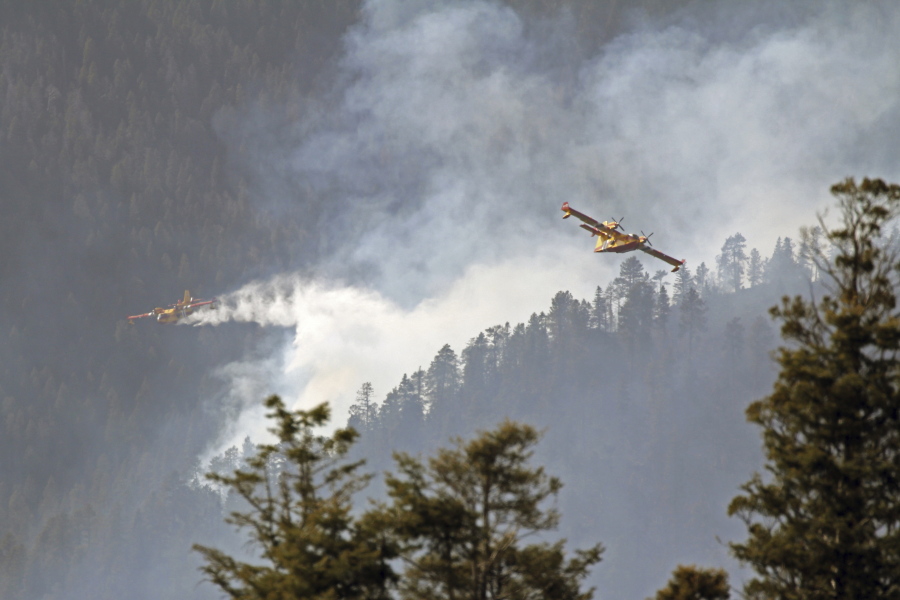ALBUQUERQUE, N.M. (AP) — Thousands of firefighters continued to slow the advance of destructive wildfires in the Southwestern U.S., but officials warned they were bracing for the return Friday of the same dangerous conditions that quickly spread the wind-fueled blazes a week ago.
At least 166 homes have been destroyed in one rural county in northeast New Mexico since the biggest fire currently burning in the U.S. started racing through small towns east and northeast of Santa Fe on April 22, the local sheriff said.
Winds gusting up to 50 mph (80 kph) were forecast Friday in the drought-stricken region. One expert said it’s a recipe for disaster on the wildlands where some timber has a fuel moisture drier than kiln-dried wood.
“It’s a very, very dangerous fire day tomorrow,” fire behavior specialist Stewart Turner said at a briefing Thursday night on the edge of the Santa Fe National Forest in Las Vegas, New Mexico.
“Like we saw last Friday, epic fire behavior,” Turner said. “It’s a day that as a firefighter, we’ll write about, we’ll read studies about. It’s going to be a big fire day.”
A swath of the country stretching from Arizona to the Texas panhandle is expected to be hit the hardest by the return of the bad firefighting weather that has generated unusually hot and fast-moving fires for this time of year, forecasters warned.
Red flag warnings for extreme fire danger were in place Thursday for all of New Mexico and parts of Arizona, Nevada, Colorado, Texas, Oklahoma and Nebraska.
More than 3,000 firefighters were battling fires in Arizona and New Mexico on Thursday — about half of those in northeast New Mexico, where more than 187 square miles (484 square kilometers) of mostly timber and brush has been charred.
They focused Thursday on preventing it from moving into the rural New Mexico community of Ledoux. That meant bolstering fire lines and sending in crews tasked with protecting structures.
“Great progress again today,” incident commander Carl Schwope said Thursday night. But “tomorrow has the potential to be a very destructive day.”
“It will be chaotic if anything close to what happened (last) Friday occurs,” added operations chief Jayson Coil.
Sheriff Chris Lopez, of New Mexico’s Miguel County, confirmed for the first time Thursday night the fire there has destroyed at least 166 homes, 108 outbuildings and three commercial buildings. He joined authorities in neighboring Mora County in pleading with residents to pay close attention Friday to sudden changes in closures and evacuation orders.
“Falling trees, possibly falling power lines, that’s the kind of winds we’re looking at,” Lopez said.
Turner, the fire behavior specialist, said the gusty winds are only part of the problem. He said moisture levels in downed logs and woody debris are “extremely dry” — just 2% in small twigs, pine needles and grasses that “actually carry a forest fire across the landscape.”
Moisture in a small log “the size of a 4-by-4 post you buy at the lumber store … are coming down to 8%,” he said. “Kiln-dry is 12%. So out there, that’s drying to what a kiln would do.”
In northern Arizona, authorities downgraded some some evacuation orders at a fire that has destroyed at least 20 homes near Flagstaff. It’s now estimated to be 43% contained. Another fire 10 miles (16 km) south of the community of Prescott was 23% contained, but officials at both blazes warned of worsening conditions expected Friday.
Elsewhere, one national wildfire managment incident team continued to oversee a large prairie fire in Nebraska, where more than 200 firefighters were battling a blaze that has been burning since last week.
About 68 square miles (176 square kilometers) of mostly grasses and farmland have been blackened near Nebraska’s state line with Kansas. Several homes were destroyed and at least one person was killed. That fire was 88% contained Thursday.
Sonner reported from Reno, Nevada. Associated Press writer Margery A. Beck contributed to this report from Omaha, Nebraska.




